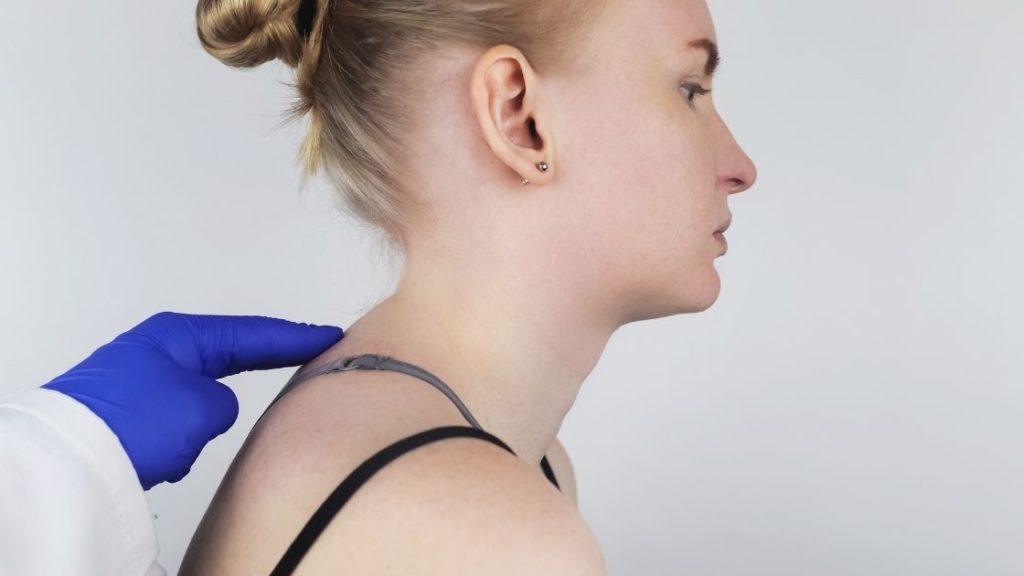What is Kyphosis: Causes and Prevention

Sometimes, the only symptom of kyphosis is the exaggerated rounding of the upper back. Others experience muscle stiffness and pain. In more serious cases, it can be accompanied by balance problems, trouble breathing, weakness in the legs, and extreme fatigue.
What causes kyphosis and what can be done to prevent it?
Causes of Kyphosis
Genetics
When a disruption in spine development occurs before birth, congenital kyphosis may occur. Genetics can play a role in the risk of congenital kyphosis.
Poor Posture
Postural kyphosis is caused by chronic slouching and poor posture. When the neck hangs forward, the muscles and ligaments holding the spine in place overstretch. The excessive stretch pulls the spine out of alignment.
Abnormally Shaped Vertebrae
Normal vertebrae have a rectangular shape. When vertebrae develop improperly, taking on a wedge or triangular shape, Scheuermann’s kyphosis takes place. The wedge-shaped vertebrae, rather than stacking straight, curve forward and cause the spine to round.
Medical Conditions
The following conditions have been shown to cause kyphosis:
- Osteoporosis
- Disk degeneration
- Spondylosis
- Spina bifida
- Muscular dystrophy
- Neurofibromatosis
- Paget’s disease
- Tuberculosis
- Cancer
- Compression fracture
How to Prevent Kyphosis
Improve Posture
- There are small steps you can take to improve your posture.
- Postural kyphosis can be both prevented and corrected through improving posture.
Be Mindful with Heavy Objects
- A heavy backpack is just as damaging, if not more so, than long hours hunched at a desk.
- When lifting, be sure to use proper form.
Get Enough Calcium and Vitamin D
- Calcium and vitamin D are vital to your bone health. An adequate amount will decrease the chances of bone conditions associated with kyphosis.
- Risk of congenital kyphosis decreases when expectant mothers receive their recommended intake.
Receive Bodywork
- Chiropractic care can be utilized to maintain proper spinal alignment.
- Massage therapy treats the muscular adhesions that pull the spine from its intended position.
Assistive Devices
- Get fitted for a postural back brace. It can be especially helpful to wear while walking, working at a desk, or doing daily chores.
Please note that not all cases of kyphosis can be prevented or reversed. When kyphosis is congenital or goes untreated for a long period of time, treatment should be sought to prevent the curvature from becoming worse. Bodywork and physical therapy can be used to improve spinal functioning and relieve pain. If left alone for too long, surgery may be the only option for relief. Before receiving any treatment for kyphosis, consult your physician for the next steps toward a healthier spine.
Now You Know!
Stay happy, healthy, and take care of your spine!
Katrina Jenkins
Author, Licensed Massage Therapist
Katrina Jenkins graduated from Towson University in 2013 with a Bachelor’s Degree in Health Science and worked as a nurse’s aide briefly before pursuing her true passion. She graduated from the Massage Therapy Institute of Colorado in April 2016 with honors and completed the Touch of Healers Scholarship Program the following summer. She has been a part of the Moyer Total Wellness Team since the summer of 2017.
Resources
Halanski, M.A., Hildahl, B., Amundson, L.A., Leiferman, E., Gendron-Fitzpatrick, A., Chaudhary, R., Hartwig-Stokes, H.M., McCabe, R., Lenhart, R., Chin, M., Birstler, J. and Crenshaw, T.D. (2018). Maternal Diets Deficient in Vitamin D Increase the Risk of Kyphosis in Offspring: A Novel Kyphotic Porcine Model. The Journal of Bone and Joint Surgery. American Volume, [online] 100(5), pp.406–415. Available at: https://pubmed.ncbi.nlm.nih.gov/29509618/.
Lam, J.C. and Mukhdomi, T. (2021). Kyphosis. [online] PubMed. Available at: https://www.ncbi.nlm.nih.gov/books/NBK558945/.
nhs.uk. (2017). Kyphosis – Causes. [online] Available at: https://www.nhs.uk/conditions/kyphosis/causes/.
Williams, N., Cundy, P.J. and Eastwod, D.M. (2017). Surgical Management of Thoracolumbar Kyphosis in Patients With Mucopolysaccharidosis. Spine, [online] 42(23), pp.1817–1825. Available at: https://pubmed.ncbi.nlm.nih.gov/28538597/.
Photo Credit
Canva by Изображения пользователя Алёна
